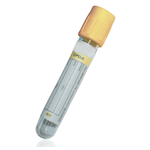Suitable Specimen Types
- Serum
- EDTA Plasma
- Li Hep Plasma
Sample Processing in Laboratory
Usual
Sample Preparation
Centrifuge
Turnaround Time
1 daySample Stability
4 ºC
Phosphate (serum)
General Information
Almost all of the phosphorus in the body occurs as phosphate (phosphorus combined with four oxygen atoms), and most of the body's phosphate (85%) is located in the skeletal system, where it combines with calcium to give bones their hardness. The remaining amount (15%) exists in the cells of the body, where it plays an important role in the formation of key nucleic acids, such as DNA, and in the process by which the body turns food into energy (metabolism). The body regulates phosphate levels in the blood through the controlled release of parathyroid hormone (PTH) from the parathyroid gland and calcitonin from the thyroid gland. PTH keeps phosphate levels from becoming too high by stimulating the excretion of phosphate in urine and causing the release of calcium from bones (phosphate blood levels are inversely proportional to calcium blood levels). Calcitonin keeps phosphate blood levels in check by moving phosphates out of the blood and into the bone matrix to form a mineral salt with calcium. Most phosphorus imbalances develop gradually and are the result of other conditions or disorders, such as malnutrition, poor kidney function, or a malfunctioning gland.
Dietary deficiencies in phosphate are rare but may be seen with alcoholism and malnutrition. Low levels of phosphate (hypophosphataemia) may also be due to or associated with:
- Hypercalcaemia (high levels of calcium), especially when due to high levels of parathyriod hormone (PTH)
- Overuse of diuretics (drugs that encourage urination)
- Severe burns
- Diabetic ketoacidosis after treatment
- Hypothyroidism
- Hypokalaemia (low levels of potassium)
- Chronic antacid use
- Rickets and osteomalacia (due to Vitamin D deficiencies)
Higher than normal levels of phosphate (hyperphosphataemia) may be due to or associated with:
- Kidney failure
- Hypoparathyroidism (underactive parathyroid gland)
- Hypocalcaemia (abnormally low levels of calcium)
- Diabetic ketoacidosis when first seen
- Phosphate supplementation
Patient Preparation
None
Notes
Haemolysis interferes with this assay
Reference Range
Neonate (<4wks) 1.3-2.6 mmol/L
Infant (4wks-1yr) 1.3-2.4 mmol/L
1-16yrs 0.9-1.8 mmol/L
Adult 0.8-1.5 mmol/L
(Source : Pathology Harmony Recommendations)
Specifications
- EQA Scheme?: Yes
-
EQA Status:
NEQAS and WEQAS
